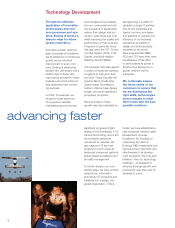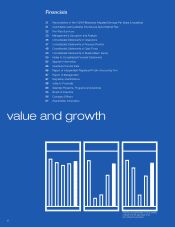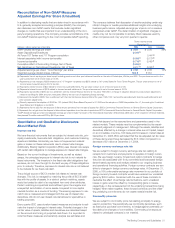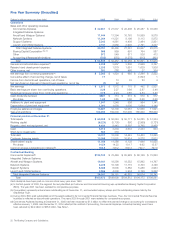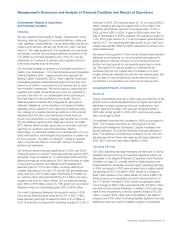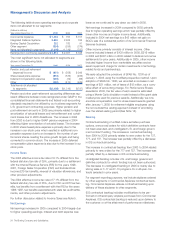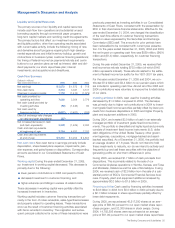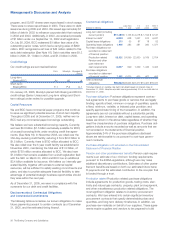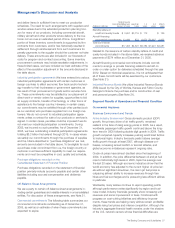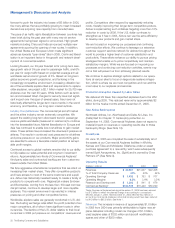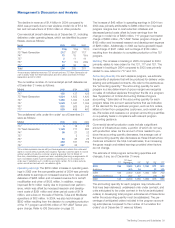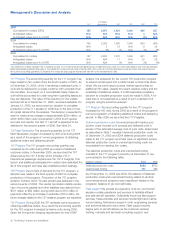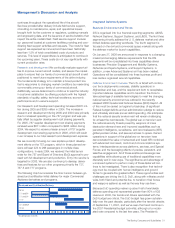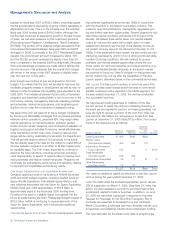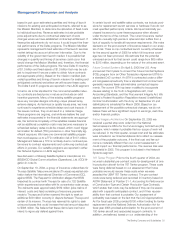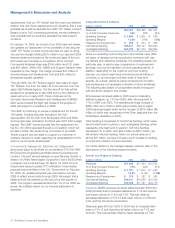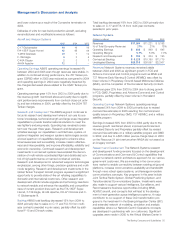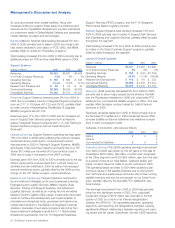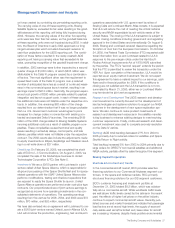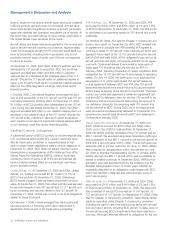Boeing 2005 Annual Report Download - page 30
Download and view the complete annual report
Please find page 30 of the 2005 Boeing annual report below. You can navigate through the pages in the report by either clicking on the pages listed below, or by using the keyword search tool below to find specific information within the annual report.
Management’s Discussion and Analysis
forecast to push the industry into losses of $6 billion in 2005,
the many airlines that are profitably growing to meet increased
demand are acquiring new capacity from manufacturers.
The pace of air traffic rights liberalization between countries has
been brisk during the past year with many new air service
agreements having been signed or announced. High growth
markets including China and India announced multiple new
agreements spurring the opening of new routes. In addition,
the United States and European Union made significant
advances towards “open skies” late in 2005. Continued liberal-
ization is an important factor in the growth and network devel-
opment of commercial aviation.
Looking forward, our 20-year forecast is for a long-term aver-
age growth rate of 5% per year for passenger traffic, and 6%
per year for cargo traffic based on projected average annual
worldwide real economic growth of 3%. Based on long-term
global economic growth projections, and factoring in the
increasingly competitive environment, increasing utilization lev-
els of the worldwide airplane fleet and requirements to replace
older airplanes, we project a $2.1 trillion market for 25,700 new
airplanes over the next 20 years. While factors such as terror-
ism and increased ticket charges for security have had signifi-
cant impact over the span of several years, they have not
historically affected the longer-term macro trends in the world
economy, and therefore, our long-term market outlook.
Industry Competitiveness The commercial jet aircraft market
and the airline industry remain extremely competitive. We
expect the existing long-term downward trend in passenger
revenue yields worldwide (measured in real terms) to continue
into the foreseeable future. Market liberalization in Europe and
Asia has continued to enable low-cost airlines to gain market
share. These airlines have increased the downward pressure on
airfares. This results in continued cost pressures for all airlines
and price pressure on our products. Major productivity gains
are essential to ensure a favorable market position at accept-
able profit margins.
Continued access to global markets remains vital to our ability
to fully realize our sales potential and long-term investment
returns. Approximately two-thirds of Commercial Airplanes’
third-party sales and contractual backlog are from customers
based outside the United States.
We face aggressive international competitors that are intent on
increasing their market share. They offer competitive products
and have access to most of the same customers and suppli-
ers. Airbus has historically invested heavily to create a family of
products to compete with ours. Regional jet makers Embraer
and Bombardier, coming from the less than 100-seat commer-
cial jet market, continue to develop larger and more capable
airplanes. This market environment has resulted in intense
pressures on pricing and other competitive factors.
Worldwide, airplane sales are generally conducted in U.S. dol-
lars. Fluctuating exchange rates affect the profit potential of our
major competitors, all of whom have significant costs in other
currencies. The decline of the U.S. dollar relative to their local
currencies in 2004 put pressure on competitors’ revenues and
profits. Competitors often respond by aggressively reducing
costs, thereby improving their longer-term competitive posture.
Airbus is implementing such initiatives targeting more than 10%
reduction in costs by 2006. If the U.S. dollar continues to
strengthen as it has in 2005, Airbus can use the extra efficiency
to develop new products and gain market share.
We are focused on improving our processes and continuing
cost-reduction efforts. We continue to leverage our extensive
customer support services network for airlines throughout the
world to provide a higher level of customer satisfaction and
productivity. These efforts enhance our ability to pursue pricing
strategies that enable us to price competitively and maintain
satisfactory margins. While we are focused on improving our
processes and continuing cost reduction activities, events may
occur that will prevent us from achieving planned results.
We continue to explore strategic options related to our opera-
tions at various sites to focus on large-scale systems integra-
tion, which is where we are most competitive and can add the
most value to our airplanes and services.
Production Disruption Caused by Labor Strike
We delivered 29 fewer than expected airplanes due to the IAM
strike, during 2005. This reduced revenue by approximately $2
billion for the twelve months ended December 31, 2005.
New Airline Bankruptcies
Northwest Airlines, Inc. (Northwest) and Delta Air Lines, Inc.
(Delta) filed for Chapter 11 bankruptcy protection on
September 14, 2005. Commercial Airplanes does not expect a
material impact on revenues or operating results due to these
bankruptcy filings. (See Note 10).
Divestitures
On June 16, 2005 we completed the sale of substantially all of
the assets at our Commercial Airplanes facilities in Wichita,
Kansas and Tulsa and McAlester, Oklahoma under an asset
purchase agreement to a new entity, which was subsequently
named Spirit Aerosystems, Inc. (Spirit) and is owned by Onex
Partners LP. (See Note 8).
Operating Results
(Dollars in millions) 2005 2004 2003
Revenues $««22,651 $21,037 $22,408
% of Total Company Revenues 41% 40% 44%
Operating Earnings $««««1,432 $«««««753 $«««««707
Operating Margins 6.3% 3.6% 3.2%
Research and Development $««««1,302 $«««««941 $«««««676
Contractual Backlog* $124,132 $70,449 $63,929
*Note: Commercial Airplanes backlog at December 31, 2005 has been reduced
by $7.8 billion to reflect the planned change in accounting for concessions
effective January 1, 2006. Had December 31, 2004 reflected this method of
accounting, Commercial Airplanes contractual backlog would have been reduced
by $4.9 billion to $65.5 billion. See Note 1.
Revenues The increase in revenue of approximately $1.6 billion
in 2005 from 2004 was primarily attributable to higher new air-
plane deliveries including model mix changes of $1.0 billion,
used airplane sales of $302 million and aircraft modification,
spares and other of $300 million.
28 The Boeing Company and Subsidiaries


